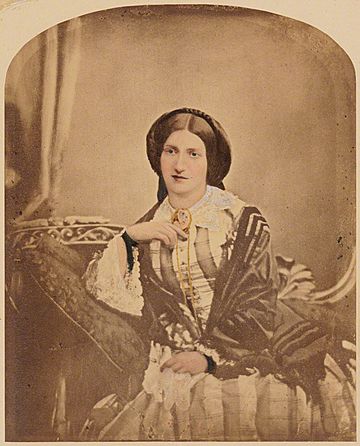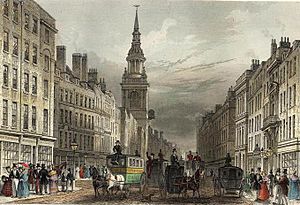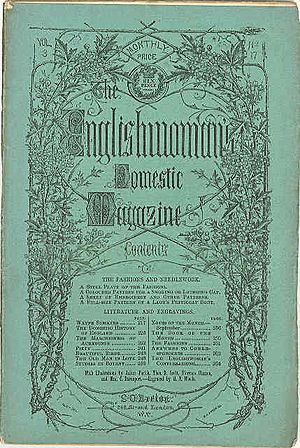Isabella Beeton facts for kids
Isabella Mary Beeton (born Mayson; 14 March 1836 – 6 February 1865), known as Mrs Beeton, was a famous English writer and editor. She is best known for her book, Mrs Beeton's Book of Household Management, published in 1861. This book became a guide for managing a home and cooking in Victorian England.
Isabella was born in London. She went to school in Islington, north London, and Heidelberg, Germany. In 1856, she married Samuel Orchart Beeton, who was a publisher and magazine editor.
In 1857, Isabella started writing for her husband's magazine, The Englishwoman's Domestic Magazine. She translated French stories and wrote the cooking section. Many of her recipes came from other books or were sent in by readers. In 1859, the Beetons began publishing monthly parts of what would become Mrs Beeton's Book of Household Management. The full book came out in October 1861 and sold 60,000 copies in its first year.
Isabella Beeton was working on a shorter version of her book when she became ill and passed away in February 1865, at the age of 28. She had four children, but sadly, two of them died when they were very young.
Mrs Beeton's Book of Household Management has been updated and reprinted many times since her death. It is still available today. Isabella Beeton's name is now linked with knowledge about Victorian cooking and home management. The Oxford English Dictionary even says that by 1891, "Mrs Beeton" was a common term for someone who was an expert on running a home. She also helped shape the idea of what a middle-class family was like in the Victorian era.
Contents
Biography
Early Life and Family (1836–1854)
Isabella Mayson was born on 14 March 1836 in Marylebone, London. She was the oldest of three daughters. Her father, Benjamin Mayson, was a linen merchant. Her mother was Elizabeth Jerrom. Soon after Isabella was born, her family moved to Milk Street in Cheapside.
When Isabella was four years old, her father died. Her mother, Elizabeth, was pregnant and found it hard to manage the business and raise the children alone. So, she sent her two older daughters to live with relatives. Isabella went to live with her grandfather in Great Orton, Cumberland. However, she returned to her mother within two years.
Three years after Benjamin's death, Elizabeth married Henry Dorling. He was a widower with four children. Henry worked as the Clerk of Epsom Racecourse and lived on the racecourse grounds. The family, including Isabella's grandmother, moved to Surrey. Over the next twenty years, Henry and Elizabeth had thirteen more children.
Isabella played a big part in raising her many younger brothers and sisters. She called them a "living cargo of children." This experience taught her a lot about managing a large family and a household.
Isabella had a short time at a boarding school in Islington. In 1851, she went to school in Heidelberg, Germany, with her stepsister Jane Dorling. Isabella became very good at playing the piano and learned French and German well. She also learned how to make pastry. By the summer of 1854, she was back in Epsom and took more pastry-making lessons from a local baker.
Marriage and Early Career (1854–1861)
Around 1854, Isabella Mayson met Samuel Orchart Beeton. His family had lived on Milk Street at the same time as the Maysons. Samuel's sisters had also attended the same school in Heidelberg as Isabella. Samuel was a successful publisher. He was the first British publisher of Uncle Tom's Cabin in 1852. He also started two new magazines: The Englishwoman's Domestic Magazine in 1852 and Boys' Own magazine in 1855.
Isabella and Samuel started writing many letters to each other in 1855. They announced their engagement in June 1855. They got married at St Martin's Church in Epsom in July 1856. Samuel believed strongly in equality for women. Their relationship was a partnership, both personally and professionally. After their wedding, they went to Paris for a three-week honeymoon. Then they visited Heidelberg before returning to Britain in August. The newlyweds moved into a large house in Pinner.
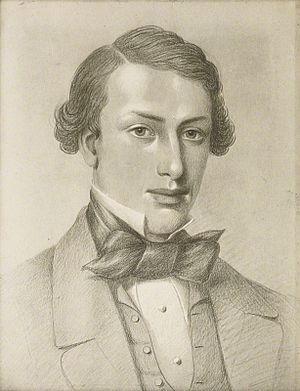
Within a month of their honeymoon, Isabella became pregnant. A few weeks before her baby was born, Samuel asked Isabella to write for The Englishwoman's Domestic Magazine. This magazine was made to help women feel happy with their lives at home. It was affordable and popular, selling 50,000 copies a month by 1856.
Isabella started by translating French stories for the magazine. Soon after, she began working on the cooking and household advice sections. The Beetons' first son, Samuel Orchart, was born in May 1857, but he sadly died in August of that year.
Even while dealing with the loss of her child, Isabella continued to work for the magazine. She and Samuel gathered recipes from many places. They asked readers to send in their own recipes, and over 2,000 were submitted. They also copied recipes from other published cookbooks. This was a common practice at the time. By using recipes from readers and other books, the magazine showed what people were actually cooking in mid-Victorian society.
The Beetons changed the way recipes were presented. Instead of listing the method first, they listed the ingredients needed before the cooking steps. Isabella's recipes also included the estimated cost, when ingredients were in season, and how many servings each dish made. Her writing was praised for being clear and detailed. This consistent way of organizing information made the book easy to use and understand.
During a very cold winter in 1858–59, Isabella made her own "Soup for benevolent purposes" to give to the poor people of Pinner. Her sister remembered that Isabella was "busy making [the] soup for the poor." This soup recipe was the only one in her famous Book of Household Management that was truly her own. The couple's second son, also named Samuel Orchart Beeton, was born in June 1859.
As early as 1857, the Beetons thought about turning the magazine columns into a book. In November 1859, they started publishing monthly supplements to The Englishwoman's Domestic Magazine. These supplements were 48 pages long and would later become the full book.
In March 1860, the Beetons went to Paris to improve the magazine's fashion section. They made a deal with a French publisher to get full-sized dress patterns and illustrations for their magazine. The first issue with this new feature came out on 1 May. For the redesigned magazine, Isabella became a co-editor with Samuel. She was described as "Editress." Isabella brought good organization and business skills to Samuel's often messy approach. She joined her husband at work, traveling daily by train to the office. In June 1860, the Beetons took a holiday to Killarney, Ireland. They enjoyed sightseeing and even worked on the next magazine issue when it rained. Isabella was impressed with the French-style food they ate there.
In September 1861, the Beetons launched a new weekly publication called The Queen, the Ladies' Newspaper. They hired Frederick Greenwood as the editor for this new magazine.
Mrs Beeton's Book of Household Management and Later Life (1861–1865)
I must frankly own, that if I had known, beforehand, that this book would have cost me the labour which it has, I should never have been courageous enough to commence it.
The complete Mrs Beeton's Book of Household Management, which brought together all 24 monthly parts, was published on 1 October 1861. It was a very important publishing event of the 1800s. Isabella included a detailed 26-page "Analytical Index" in the book, making it easy to find information.
Out of 1,112 pages, over 900 contained recipes. The rest of the book gave advice on many topics. These included fashion, child care, how to look after animals, poisons, managing servants, science, religion, first aid, and the importance of using local and seasonal food. In its first year, the book sold 60,000 copies.
The book showed Victorian values like hard work, saving money, and cleanliness. It gave an optimistic message that Victorian England offered many chances for those willing to learn. Many people thought it was the best book for young women who knew little about running a home.
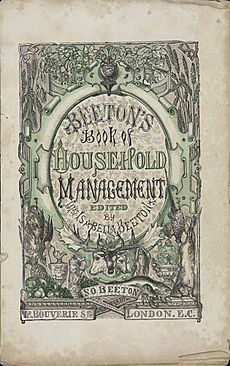
The reviews for Book of Household Management were very positive. Critics said Isabella Beeton had earned a great reputation. They believed her book would be a valuable treasure in every English home for years to come. Reviewers praised the clear information and the helpful layout of the recipes. They liked the details about ingredients, seasonality, and cooking times. One reviewer said that "Mrs Beeton has omitted nothing which tends to the comfort of housekeepers."
Samuel's business decisions after 1861 were not always good. He lost money on some investments. This led to financial problems, and in early 1862, the couple had to move from their comfortable Pinner house to rooms above their office in central London. The city air was not good for their son's health, and he became ill. He passed away on New Year's Eve 1862, at the age of three.
In March 1863, Isabella became pregnant again. In April, the couple moved to a house in Greenhithe, Kent. Their son, Orchart, was born on New Year's Eve 1863. Although they had faced money problems, 1863 was a good year for them. They sold The Queen magazine, which helped their finances.
In mid-1864, the Beetons visited Paris again. Isabella was pregnant during this trip. When she returned to Britain, she started working on a shorter version of the Book of Household Management, called The Dictionary of Every-Day Cookery. On 29 January 1865, while working on the proofs for the dictionary, she gave birth to her baby, Mayson Moss. Isabella became feverish the next day and passed away on 6 February, at the age of 28, due to complications after childbirth.
Isabella Beeton was buried at West Norwood Cemetery on 11 February.
Legacy and Influence
In May 1866, Samuel Beeton faced serious financial difficulties. He sold the rights to Mrs Beeton's Book of Household Management to Ward, Lock and Tyler. Some people believe this was a very bad deal for Samuel, given how much money the company later made from the book.
In later editions, Ward Lock often hid the details of Isabella's life and death. They wanted readers to think she was still alive and creating recipes. This was a way to protect their investment. These later versions of the book, still bearing Beeton's name, became less like the original. Since it was first published, Mrs Beeton's Book of Household Management has been printed many times, translated into different languages, and has never gone out of print.
Over the years, Isabella Beeton and her main work have received some criticism. Some food writers have pointed out that some recipes can be confusing. However, others, like food writer Bee Wilson, believe that criticizing Beeton's work is just a "fashionable" thing to do. Wilson says that Beeton's writing "simply makes you want to cook." Some experts suggest that any problems with the book came from later editors changing it.
Despite some criticism, Mrs Beeton's Book of Household Management has been the most popular English cookbook for over a century. It often sells more copies than any other book except the Bible. The Oxford English Dictionary notes that by 1891, "Mrs Beeton" became a general term for an expert on cooking and home topics. Her name became a well-known brand.
In 2009, a review in The BMJ (a medical journal) called Mrs Beeton's Book of Household Management a medical classic. The reviewer said that Beeton's efforts to teach average readers about common health problems were similar to today's family health guides. A professor of strategic management, Robin Wensley, believes that Beeton's advice on household management can also apply to business management. He thinks her lessons on this topic are still useful today.
There have been several books and television shows about Isabella Beeton. These include biographies like Mr and Mrs Beeton and The Beeton Story. On television, Margaret Tyzack and Anna Madeley have played Isabella Beeton. Sophie Dahl also presented a documentary called The Marvellous Mrs Beeton.
Historians see Isabella Beeton as a powerful influence in shaping what it meant to be a middle-class Victorian family. Her book brought together different parts of home science into one volume. This helped to raise the importance of the middle-class female housekeeper's role. One academic said that "Mrs Beetonism has preserved the family as a social unit." Another historian, Nicola Humble, believes The Book of Household Management was a "force for social change" that led to a new focus on home life in the Victorian era.
|
See also
 In Spanish: Isabella Beeton para niños
In Spanish: Isabella Beeton para niños


